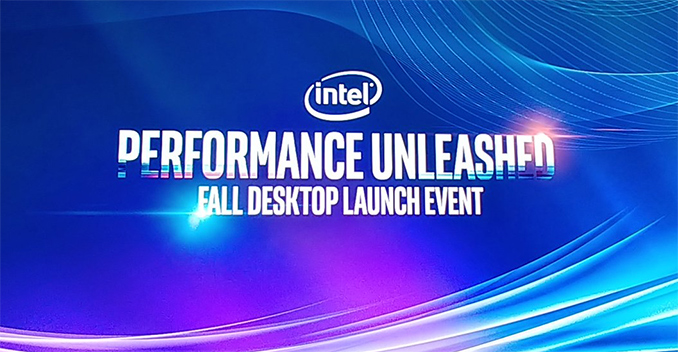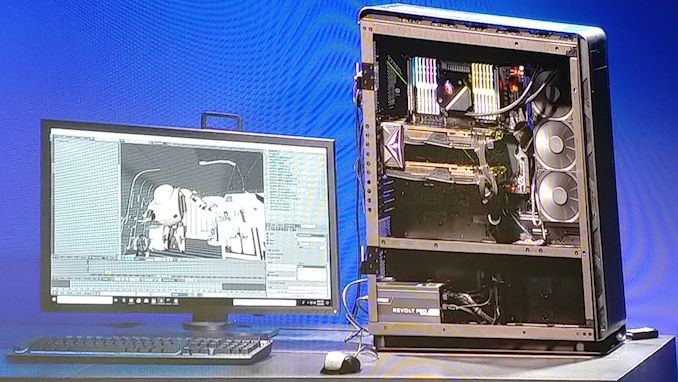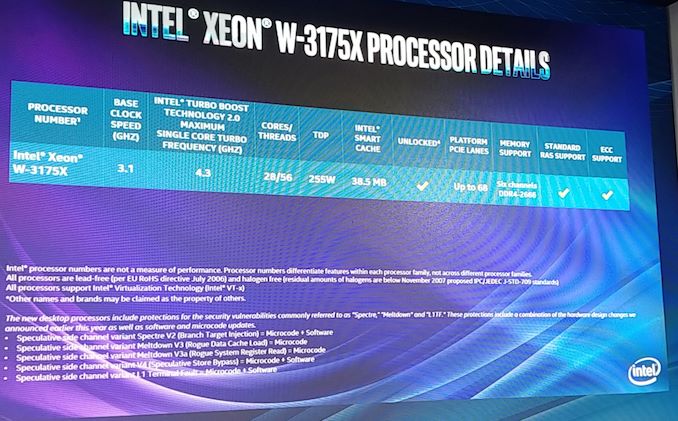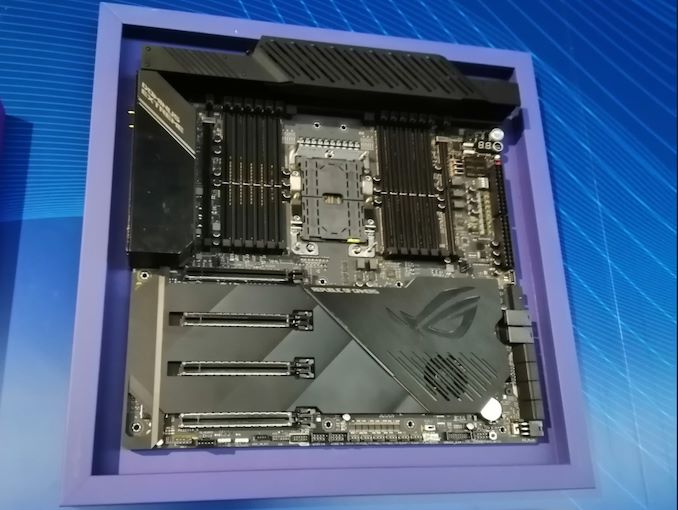Intel Announces Xeon W-3175X: 28-Core Processor for Extreme Workstations
by Anton Shilov on October 8, 2018 10:54 AM EST
Intel on Monday officially introduced its 28-core processor for extreme workstations that it teased first back in June. The new chip comes with unlocked multiplier and can run at up to 4.3 GHz in burst mode.
The Intel Xeon W-3175X CPU is based on the Skylake/Cascade Lake microarchitecture and is compatible with motherboards featuring Intel’s LGA3647 server-based socket. The CPUs runs at 3.1 GHz stock, but can increase its frequency to 4.3 GHz, it features a six-channel DDR4 memory controller that supports up to 512 GB and a massive 38.5 MB cache. Since the chip uses a new socket, it is naturally not compatible with any motherboards available on the market. Meanwhile, to date, only ASUS and GIGABYTE have confirmed plans to offer mainboards for Intel’s Xeon W-3175X.
The new 28-core processor has a massive TDP of 265 W and considering the fact that it comes with an unlocked multiplier and can be overclocked, that power draw may get even higher. That said, the Xeon W-3175X will require a very robust cooling system, preferably a liquid-based one. At least, Intel itself demonstrated the chip with a cooler featuring two fans and a 240-mm radiator.
Intel aims the Xeon W-3175X primarily at content creators, which is why the platform offers 68 PCIe lanes (44 on the CPU + 24 on the chipset), enough to install more than one graphics card, numerous high-end NVMe SSDs, and whatever special-purpose accelerator is required.
The newly unveiled ASUS ROG Dominus Extreme is specifically designed for use with the new Xeon W-3175X processor which is the newly announced 28-core processor, which given official specification are currently unavailable we know is going to require a large amount of power draw. To compliment this the ROG Dominus Extreme features not just one, but two 24-pin ATX power connectors along with four 8-pin and two 6-pin 12 V ATX power connectors to provide enough power. The ROG Dominus Extreme is based on the EEB ATX form factor and has a total of twelve DDR4 slots which should support for up to a maximum of 192 GB of system memory.
On the bottom half of the board there’s a total of four full-length PCIe 3.0 lanes which should support four-way SLI and CrossFire for one of the most Goliathan gaming systems going; bearing in mind that this platform is designed primarily for professional workstation users, the ROG branding indicates otherwise. The PCB is covered by a wave of armor which looks clean and featured on this is a large ROG logo. Underneath this looks to be a chipset cooling fan which it’s likely will run warm due to the nature of this particular board.
In the top right-hand corner is a set of buttons which look to include a power, reset and potentially a clear CMOS switch. Also featured is an LED debug and to the left of the ROG DIMM.2 slot for M.2 PCIe 3.0 x4 SSDs is a quadruplet of dip switches; these are most likely to enable or disable the individual PCIe 3.0 x16 slots.
This is a breaking news. We update the story as we get more information.
Related Reading:













32 Comments
View All Comments
simpleplan - Monday, October 8, 2018 - link
No thunderbolt no deal. How could they miss that, when it was aimed at content creators.M O B - Thursday, October 11, 2018 - link
I see a TB header in the bottom left-hand corner on that board. Do you have some reason to think that header is non-functional?oRAirwolf - Monday, October 8, 2018 - link
I'm sure this will be competitively priced to compete with the 2990WX /stwtech - Monday, October 8, 2018 - link
Given that the refreshed 18 core costs $2,000, and it uses the same die as a nearly $9K server chip, my guess is that this - as a single-socket only workstation chip - will be priced between $3,000 and $4,200 - my personal prediction is right down the middle at $3,599.It would be even more expensive - if it ever came out at all - if not for the competition from AMD. But AMD fumbled a little by gimping memory access on the 2990WX. They had a chance to knock it out of the park with that one, as a relatively high clockspeed 32-core workstation CPU. Instead, it ended up only being useful for a subset of workloads. This Intel processor won't have any such limitations, and so it will likely be the go-to workstation chip for most uses that can benefit greatly from high core counts.
It will be commonly used to replace prior-gen dual-socket workstations running a pair of ~$2K CPUs, so the total system cost will probably remain about the same.
SaturnusDK - Tuesday, October 9, 2018 - link
A lot of driver updates under the bridge since the 2990WX launch though which removes a lot of those early driver problems with memory access. A lot of reviewers were also not aware that vast performance improvements could be had if you moved all processes of the 0/1 core except OS processes. Presumably because it wasn't known by even AMD at the time. Furthermore, for those testing gaming on the 2990WX (for some reason) and tested using the Wraithripper that blocks the top PCI-e slot that is directly connected to the CPU die that game threads defaults to start from, they'd naturally see far higher results if they used core affinities to move these threads to the CPU die that is actually directly connected to the PCI-e slot that has the graphics slot. Most of these issues should be corrected now though.This is not to excuse AMD though. Clearly these are workarounds that could have been largely avoided with due diligence testing. But AMD can always say: "you want the highest possible memory performance, well, suck it up and buy an EPYC instead". And that is really the end of it. The Threadripper 2 line offers extremely high performance at an extremely low price point. It is not however a jack of all trades (until you get to the lower tier SKUs).
twtech - Monday, October 15, 2018 - link
And Epyc would be a reasonable alternative if it clocked high enough. The Epyc 7601 has a base clock of 2.2 GHz, with a 3.2 GHz boost. That's about 1/3 slower than this Intel chip is going to clock at. For server applications, that makes sense. For workstation applications, we'd like to have our cake and eat it too - high clockrate for regular single-threaded tasks, and a lot of cores when we can make use of them.Hopefully Epyc 2, if it comes in a 64-core flagship variant, will also include a high-clocked 32-core variant that will be ideal for workstation use.
Dr. Swag - Tuesday, October 9, 2018 - link
I feel like it might cost even more because of the xeon name. Otherwise I probably woulda said 4k max but xeon raises the price a lot...twtech - Monday, October 15, 2018 - link
The factor that allows for a bit lower price is that it's limited to a single-socket installation. That's the big differentiating factor between this chip and the server chip it's based on. This is going to be in the Xeon W line - not Xeon Gold/Platinum. The Xeon W-2195 (18 core) has a list price of $2,553; which is about $500 more than the equivalent i9.So I suppose they could still go a bit higher - $4,500 maybe - but I can't see them going much beyond that, if they really want this to be considered a competitor for AMD's chips.
Dark_Complex - Monday, October 8, 2018 - link
You have got the PCIe lane split wrong, it is 48 CPU + 20 PCH, not 44 CPU + 24 PCH like on the Core X models, check the block diagram from the liveblog. Also, do we know if the UPI lanes which have apparently been repurposed as misc IO (see mesh diagram from the liveblog) will actually be used by motherboard vendors for anything?Ian Cutress - Tuesday, October 9, 2018 - link
The image Intel showed said 48 + 24, and they said verbally 44+24.